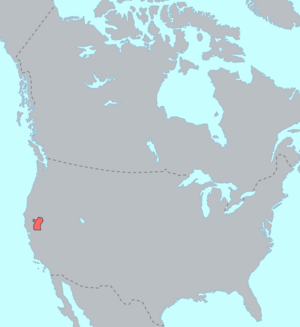Maidu language facts for kids
Quick facts for kids Northeastern Maidu |
||||
|---|---|---|---|---|
| Májdy | ||||

Maidu greeting on sign in Indian Valley, California
|
||||
| Native to | United States | |||
| Region | California | |||
| Extinct | 2007e18 | |||
| Language family |
Maiduan
|
|||

Pre-contact distribution of Maiduan languages
|
||||
|
||||
Maidu is a language that was spoken by the Maidu people in California, United States. It is also known as Northeastern Maidu or Mountain Maidu. The Maidu people traditionally lived in the mountains east and south of Lassen Peak. This area includes parts of the American River and Feather River basins. Some of the valleys where they lived are Indian Valley, American Valley, Butte Valley, and Big Meadows.
The Maidu language is part of the Maiduan language family. Other related languages include Konkow and Nisenan. Sadly, the Maidu language became extinct in 2007. However, there are efforts to bring it back!
Contents
The Maidu People's Past
Long ago, before Europeans arrived, the Maidu people lived by hunting and gathering food. They lived in central California. Their lands stretched around places like Mount Lassen, Honey Lake, Sacramento, and Lake Tahoe.
The Maidu people spoke languages that were very similar. These included the Maidu, Konkow, and Nisenan languages. Some other Maidu languages, like the Chico language, are no longer spoken today.
Bringing the Language Back
People are working hard to bring the Maidu language back to life. These efforts have been going on since 2004.
One important person was Farrell Cunningham. He was one of the youngest people who spoke the Yamani Maidu language fluently. He taught Mountain Maidu language classes in different towns. These included Greenville, Susanville, Nevada City, and Auburn. He also worked with the Maidu Theater in Nevada City. Sadly, he passed away in 2013 at age 37.
As of 2011, you could take Maidu language classes in Nevada County, California. This helps new generations learn and speak the language.
The Maiduan language family is part of a bigger group called Penutian languages. Other language families in this group include Miwok, Wintun, Yokuts, and Ohlone.
How Maidu Words Work
Languages have rules for how words are built and how they change. This is called morphology. In Maidu, words often have a main part, called a stem, and then smaller parts, called suffixes, added to the end. These suffixes change the meaning of the word.
Maidu Nouns
Nouns are words for people, places, or things. Maidu nouns can be divided into two main groups.
- The first group is for words like "mother" or "father." These words are always connected to someone who owns them, like "my mother" or "your mother."
- The second group includes most other nouns, like "coyote" or "mountain." These words can stand alone. Sometimes, a noun can change its form when suffixes are added. For example, the word for "woman" might change slightly when you add a suffix to make "old woman" or "women."
Maidu also has pronouns, which are words like "I," "you," and "he/she/they." In Maidu, pronouns change to show if they are singular (one), dual (two), or plural (more than two).
Maidu Verbs
Verbs are action words, like "sing" or "dig." In Maidu, verbs are made up of a main part, called the verb stem, and then different suffixes. These suffixes can change what the verb means.
- Some verbs are simple, like "sing."
- Others are made by combining two words. For example, the word for "to dig a hole" comes from combining "dirt" and "to dig."
- Sometimes, verbs are made from two action words put together, like "to believe" from "to have enough" and "to see."
Changing Verb Meanings
Maidu verbs use suffixes to show different things:
- Causative: This suffix means someone is causing an action. For example, adding this suffix to "die" makes it "to kill" (to cause to die).
- Negative: This suffix makes a verb negative, like "didn't dance" or "won't."
- Aspectual: These suffixes show how an action happens. For example, one suffix means "completion," like "I'm through talking." Another means "unable," like "I can't get out of the house."
- Evidential: These suffixes show how the speaker knows something. One means "it is said," like telling a story. Another means "apparently," like something seems to be true.
Verb Tenses
Just like in English, Maidu verbs change to show when an action happens (past, present, future). This is called tense.
- Present-Past: This tense is used for actions that just finished, actions happening right now, or to describe how something is.
- Future: This tense shows an action that will happen later. It can also be a mild command.
- Other Pasts: There are also ways to show actions that happened regularly in the past, like "I used to talk."
How Maidu Sentences Are Built
Syntax is about how words are put together to form sentences. In Maidu, nouns have special endings, called case markings, that show their role in the sentence. There are ten different case markings!
- Subject: This marking shows who or what is doing the action (the performer of the verb).
- Object: This marking shows who or what the action is done to.
- Possessive: This marking shows who owns something, like "coyote's" or "my."
- Locative: There are seven different locative markings! These show where something is or where it's going.
- Comitative: Means "along with."
- Instrumental: Shows what is used to do something, like "with a flute."
- Locative: Shows a fixed place, like "in the dark."
- Allative: Means "toward" a place.
- Ablative: Shows movement "away from" something or where something came from.
- Indefinite Locative: Used for an unknown location, like "where is your dishtowel?"
- Linear Distributive: Means "along" or "alongside of" something that has a line shape, like a river.
Word Order in Maidu
In English, we usually say Subject-Verb-Object (like "The dog chased the ball"). Maidu has more flexible word order.
- The most common word order is Subject-Locative-Verb.
- The verb is usually at the end of the sentence.
- However, the order can change. You might see Verb-Subject-Object or other combinations. The main thing is that the possessive word usually comes at the very end of the sentence.
Here are some examples of how sentences are put together in Maidu:
- That man is my friend.
- I used to go to the mountains with my younger brother in the summer.
- That woman used to weave baskets.

